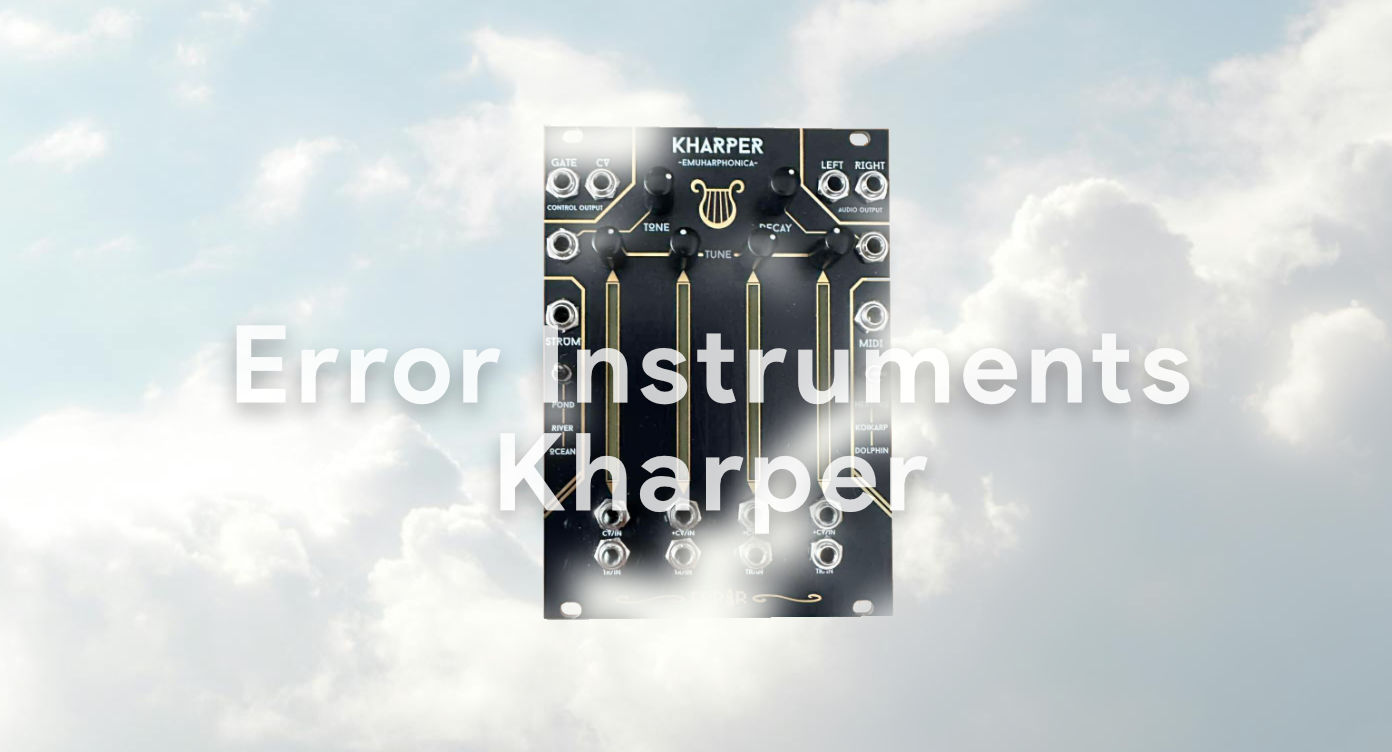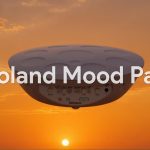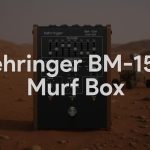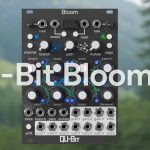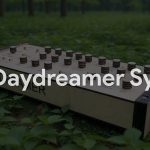The Harp That Swims in Digital Waters
Most synthesizers try to recreate familiar sounds or push boundaries through brute force complexity. But Error Instruments’ kHarper takes a fundamentally different approach—it’s a physical manifestation of the Karplus-Strong algorithm that thinks like an aquatic ecosystem while feeling like an ancient stringed instrument. This isn’t just another experimental module; it’s a complete reimagining of what happens when mathematical models meet tactile expression.
The kHarper doesn’t want to be your next pop synthesizer or your go-to lead generator. It exists for those moments when you need texture, surprise, and the kind of sonic unpredictability that comes from algorithms designed to behave like living systems rather than digital machines.
Philosophy Meets Physics: The Karplus-Strong Universe
At its core, the kHarper is built around multiple implementations of the Karplus-Strong physical modeling algorithm—the mathematical approach that revolutionized digital string synthesis in the 1980s. But rather than simply implementing a single version, Error Instruments has created nine distinct sound engines arranged in three groups of three, each interpreting the algorithm through different philosophical lenses.
This isn’t academic exercise—it’s sonic exploration. The Karplus-Strong algorithm excels at creating sounds that feel organic and alive, with natural decay characteristics and harmonic complexity that emerges from the model itself rather than being imposed by the designer.
Four Strings, Infinite Expressions
The kHarper’s interface centers on four physical strings, each constructed from dual touch strips with LED bars providing visual feedback. This isn’t just clever design—it’s intuitive interaction that bridges the gap between digital algorithms and physical expression. Each string responds to touch with the kind of sensitivity that makes the difference between mechanical triggering and musical performance.
String Architecture:
- Four independent voices, each representing a complete string model
- Dual touch strips per string for nuanced control
- LED bar feedback showing algorithmic activity
- Individual tone controls for each string
- CV inputs for external modulation
- Gate inputs for precise triggering
The ability to physically touch these algorithmic models adds what Error Instruments calls “natural chaos”—the kind of unpredictable variation that makes acoustic instruments feel alive. It’s the difference between pressing a button and plucking a string, even when both actions trigger the same algorithm.
Aquatic Sound Design: Three Ecosystems of Expression
The kHarper’s sound library takes an unusual approach to categorization, organizing its nine models around aquatic life forms. This isn’t just whimsical naming—each category represents a distinct approach to the Karplus-Strong algorithm, with sonic characteristics that reflect their biological inspirations.
Herring – Cinematic Textures: Deep, lush, atmospheric sounds designed for emotional impact. These are your film score moments, ambient washes, and sustained harmonic environments. The Herring models excel at creating space and mood, perfect for soundscapes that need to breathe and evolve.
KoiKarp – Percussive and Rhythmic: Short, glitchy, percussive hits that shine in rhythmic contexts. These models transform the string algorithm into a percussion generator, creating textures that feel both organic and electronic. Perfect for triggered patterns and rhythmic punctuation.
Dolphin – Experimental and Glitch-Heavy: Overdriven, clipped, noisy, and deliberately chaotic. The Dolphin models push the Karplus-Strong algorithm into territories it was never designed to inhabit, creating sounds that feel both familiar and completely alien.
Platform, Not Product: The Open-Source Advantage
Perhaps the most forward-thinking aspect of the kHarper is its conception as a platform rather than a fixed product. The USB port on the back isn’t just for convenience—it’s an invitation to transformation. New algorithms, alternative firmwares, and completely different approaches to the hardware can be uploaded, making the kHarper a vessel for ongoing sonic exploration.
Future Possibilities:
- Traditional 1V/octave tracking for melodic control
- Alternative quantization schemes
- Ambient and generative patches
- Experimental warm or noisy algorithms
- Community-developed sound models
This open-source approach transforms the kHarper from a purchase into a platform, ensuring that its capabilities can evolve with both technological advancement and creative community input.
Control Philosophy: Hands-On Meets Modular
The kHarper’s control system reflects its dual nature as both standalone instrument and modular component. The four string interface provides immediate tactile access, while comprehensive CV and gate inputs allow for complex integration with larger modular systems.
Control Options:
- Individual tone knobs and CV inputs per string
- Global STRUM gate input for all four strings
- Pond/River/Ocean sound engine selection
- Herring/KoiKarp/Dolphin algorithm choice
- Tone and decay controls for real-time manipulation
- MIDI input for external sequencing
The combination of hands-on string control and modular integration creates performance possibilities that span from intimate solo exploration to complex ensemble arrangements.
The Sound: Organic Algorithms in Action
Sonically, the kHarper occupies territory that few other instruments can claim. The Karplus-Strong algorithm creates sounds that feel both synthetic and natural, with the kind of harmonic complexity that emerges from physical modeling rather than being imposed by design.
The range spans from meditative, bell-like tones to aggressive, distorted textures that push the algorithm into deliberate instability. Unlike traditional synthesis, where you shape sounds through familiar parameters, the kHarper invites you to discover sounds through interaction with the algorithm itself.
Connectivity: Modular Integration Made Musical
Essential I/O:
- Four individual string trigger inputs
- Global STRUM gate input
- CV inputs for tone control per string
- Left/Right audio outputs
- Control output with gate and CV
- MIDI input for external sequencing
- USB for firmware updates and sound loading
The connectivity reflects the kHarper’s role as both creative instrument and modular system component, providing enough integration options to serve as a sonic centerpiece or supporting element in larger patches.
Important Limitations: What the kHarper Isn’t
Error Instruments is refreshingly honest about what the kHarper doesn’t do. The standard firmware doesn’t track 1V/octave, making traditional melodic control challenging without MIDI. This isn’t a limitation—it’s a design choice that prioritizes textural exploration over conventional melodic synthesis.
The kHarper isn’t trying to be your next pop synthesizer. It’s not designed for traditional synthesis approaches or conventional musical applications. It’s for musicians and sound artists who prioritize texture, surprise, and sonic exploration over familiar sounds and predictable behaviors.
Performance Integration: From Sketch to Sonic Sculpture
The kHarper’s performance capabilities span from intimate solo exploration to complex modular integration. The string interface encourages the kind of physical interaction that translates directly into musical expression, while the modular connectivity allows for complex automation and sequencing.
Whether used as a standalone texture generator or integrated into larger modular systems, the kHarper provides the kind of sonic unpredictability that can transform static compositions into living, breathing musical experiences.
The Future of Experimental Sound
The kHarper represents Error Instruments’ vision of where experimental music technology is headed—toward platforms that encourage exploration rather than instruments that deliver predetermined results. By combining sophisticated algorithms with intuitive physical interfaces and open-source expandability, it creates a tool that grows with its user’s creativity.
This approach feels particularly relevant in an era where the boundaries between acoustic and electronic, composed and improvised, predictable and chaotic are increasingly blurred. The kHarper doesn’t just accommodate these contradictions—it celebrates them.
Ready to dive into algorithmic waters? Visit errorinstruments.com to explore how physical modeling can transform your relationship with digital sound.
About Me
Hi, I’m Canoy Dang. I grew up in Granada and now living in Málaga, in the south of Spain. Sound has always played a central role in my life — from early home recordings to the deeper, ongoing exploration of the modular synth world. Modular, semi-modular, and desktop synthesizers have become my main tools for expression, experimentation, and sometimes, simply for getting lost in the process.

